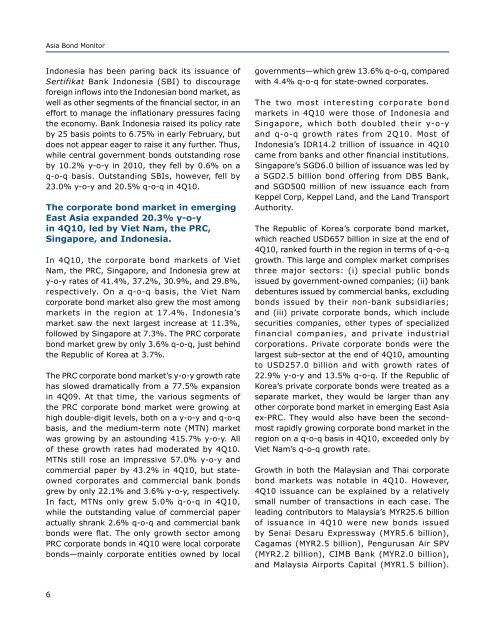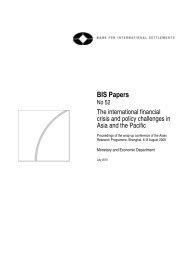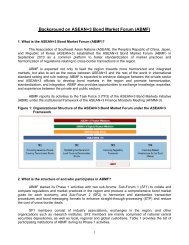asia bond monitor - AsianBondsOnline - Asian Development Bank
asia bond monitor - AsianBondsOnline - Asian Development Bank
asia bond monitor - AsianBondsOnline - Asian Development Bank
Create successful ePaper yourself
Turn your PDF publications into a flip-book with our unique Google optimized e-Paper software.
Asia Bond Monitor<br />
Indonesia has been paring back its issuance of<br />
Sertifikat <strong>Bank</strong> Indonesia (SBI) to discourage<br />
foreign inflows into the Indonesian <strong>bond</strong> market, as<br />
well as other segments of the financial sector, in an<br />
effort to manage the inflationary pressures facing<br />
the economy. <strong>Bank</strong> Indonesia raised its policy rate<br />
by 25 basis points to 6.75% in early February, but<br />
does not appear eager to raise it any further. Thus,<br />
while central government <strong>bond</strong>s outstanding rose<br />
by 10.2% y-o-y in 2010, they fell by 0.6% on a<br />
q-o-q basis. Outstanding SBIs, however, fell by<br />
23.0% y-o-y and 20.5% q-o-q in 4Q10.<br />
The corporate <strong>bond</strong> market in emerging<br />
East Asia expanded 20.3% y-o-y<br />
in 4Q10, led by Viet Nam, the PRC,<br />
Singapore, and Indonesia.<br />
In 4Q10, the corporate <strong>bond</strong> markets of Viet<br />
Nam, the PRC, Singapore, and Indonesia grew at<br />
y-o-y rates of 41.4%, 37.2%, 30.9%, and 29.8%,<br />
respectively. On a q-o-q basis, the Viet Nam<br />
corporate <strong>bond</strong> market also grew the most among<br />
markets in the region at 17.4%. Indonesia’s<br />
market saw the next largest increase at 11.3%,<br />
followed by Singapore at 7.3%. The PRC corporate<br />
<strong>bond</strong> market grew by only 3.6% q-o-q, just behind<br />
the Republic of Korea at 3.7%.<br />
The PRC corporate <strong>bond</strong> market’s y-o-y growth rate<br />
has slowed dramatically from a 77.5% expansion<br />
in 4Q09. At that time, the various segments of<br />
the PRC corporate <strong>bond</strong> market were growing at<br />
high double-digit levels, both on a y-o-y and q-o-q<br />
basis, and the medium-term note (MTN) market<br />
was growing by an astounding 415.7% y-o-y. All<br />
of these growth rates had moderated by 4Q10.<br />
MTNs still rose an impressive 57.0% y-o-y and<br />
commercial paper by 43.2% in 4Q10, but stateowned<br />
corporates and commercial bank <strong>bond</strong>s<br />
grew by only 22.1% and 3.6% y-o-y, respectively.<br />
In fact, MTNs only grew 5.0% q-o-q in 4Q10,<br />
while the outstanding value of commercial paper<br />
actually shrank 2.6% q-o-q and commercial bank<br />
<strong>bond</strong>s were flat. The only growth sector among<br />
PRC corporate <strong>bond</strong>s in 4Q10 were local corporate<br />
<strong>bond</strong>s—mainly corporate entities owned by local<br />
governments—which grew 13.6% q-o-q, compared<br />
with 4.4% q-o-q for state-owned corporates.<br />
The two most interesting corporate <strong>bond</strong><br />
markets in 4Q10 were those of Indonesia and<br />
Singapore, which both doubled their y-o-y<br />
and q-o-q growth rates from 2Q10. Most of<br />
Indonesia’s IDR14.2 trillion of issuance in 4Q10<br />
came from banks and other financial institutions.<br />
Singapore’s SGD6.0 billion of issuance was led by<br />
a SGD2.5 billion <strong>bond</strong> offering from DBS <strong>Bank</strong>,<br />
and SGD500 million of new issuance each from<br />
Keppel Corp, Keppel Land, and the Land Transport<br />
Authority.<br />
The Republic of Korea’s corporate <strong>bond</strong> market,<br />
which reached USD657 billion in size at the end of<br />
4Q10, ranked fourth in the region in terms of q-o-q<br />
growth. This large and complex market comprises<br />
three major sectors: (i) special public <strong>bond</strong>s<br />
issued by government-owned companies; (ii) bank<br />
debentures issued by commercial banks, excluding<br />
<strong>bond</strong>s issued by their non-bank subsidiaries;<br />
and (iii) private corporate <strong>bond</strong>s, which include<br />
securities companies, other types of specialized<br />
financial companies, and private industrial<br />
corporations. Private corporate <strong>bond</strong>s were the<br />
largest sub-sector at the end of 4Q10, amounting<br />
to USD257.0 billion and with growth rates of<br />
22.9% y-o-y and 13.5% q-o-q. If the Republic of<br />
Korea’s private corporate <strong>bond</strong>s were treated as a<br />
separate market, they would be larger than any<br />
other corporate <strong>bond</strong> market in emerging East Asia<br />
ex-PRC. They would also have been the secondmost<br />
rapidly growing corporate <strong>bond</strong> market in the<br />
region on a q-o-q basis in 4Q10, exceeded only by<br />
Viet Nam’s q-o-q growth rate.<br />
Growth in both the Malaysian and Thai corporate<br />
<strong>bond</strong> markets was notable in 4Q10. However,<br />
4Q10 issuance can be explained by a relatively<br />
small number of transactions in each case. The<br />
leading contributors to Malaysia’s MYR25.6 billion<br />
of issuance in 4Q10 were new <strong>bond</strong>s issued<br />
by Senai Desaru Expressway (MYR5.6 billion),<br />
Cagamas (MYR2.5 billion), Pengurusan Air SPV<br />
(MYR2.2 billion), CIMB <strong>Bank</strong> (MYR2.0 billion),<br />
and Malaysia Airports Capital (MYR1.5 billion).<br />
6







